A Survey on Contextual Embeddings
Qi Liu‡, Matt J. Kusner†∗, Phil Blunsom‡⋄,
‡University of Oxford ⋄DeepMind
†University College London ∗The Alan Turing Institute
‡{firstname.lastname}@cs.ox.ac.uk
†m.kusner@ucl.ac.uk
0
2
0
2
r
a
M
6
1
]
L
C
.
s
c
[
1
v
8
7
2
7
0
.
3
0
0
2
:
v
i
X
r
a
Abstract
Contextual embeddings, such as ELMo and
BERT, move beyond global word represen-
tations like Word2Vec and achieve ground-
breaking performance on a wide range of natu-
ral language processing tasks. Contextual em-
beddings assign each word a representation
based on its context, thereby capturing uses
of words across varied contexts and encod-
ing knowledge that transfers across languages.
In this survey, we review existing contextual
embedding models, cross-lingual polyglot pre-
training, the application of contextual embed-
dings in downstream tasks, model compres-
sion, and model analyses.
1 Introduction
Distributional word representations (Turian et al.,
2010; Mikolov et al., 2013; Pennington et al.,
2014) trained in an unsupervised manner on
large-scale corpora are widely used in modern
natural language processing systems. However,
these approaches only obtain a single global rep-
resentation for each word, ignoring their context.
Different from traditional word representations,
contextual embeddings move beyond word-level
semantics in that each token is associated with a
representation that is a function of the entire input
sequence. These context-dependent representa-
tions can capture many syntactic and semantic
properties of words under diverse linguistic
Previous work (Peters et al., 2018;
contexts.
Devlin et al., 2018; Yang et al., 2019; Raffel et al.,
2019) has shown that contextual embeddings pre-
trained on large-scale unlabelled corpora achieve
state-of-the-art performance on a wide range of
natural language processing tasks, such as text
classification, question answering and text sum-
marization. Further analyses (Liu et al., 2019a;
Hewitt and Liang,
2019; Hewitt and Manning,
2019; Tenney et al., 2019a) demonstrate that
contextual embeddings are capable of learning
useful and transferable representations across
languages.
The rest of the survey is organized as follows.
In Section 2, we define the concept of contextual
embeddings. In Section 3, we introduce existing
methods for obtaining contextual embeddings. In
Section 4, we present the pre-training methods of
contextual embeddings on multi-lingual corpora.
In Section 5, we describe methods for applying
pre-trained contextual embeddings in downstream
tasks. In Section 6, we detail model compression
methods.
In Section 7, we survey analyses that
have aimed to identify the linguistic knowledge
learned by contextual embeddings. We conclude
the survey by highlighting some challenges for fu-
ture research in Section 8.
2 Token Embeddings
Consider a text corpus that
is represented as
a sequence S of tokens, (t1, t2, ..., tN ). Dis-
tributed representations of words (Harris, 1954;
Bengio et al., 2003) associate each token ti with
a dense feature vector hti . Traditional word em-
bedding techniques aim to learn a global word em-
bedding matrix E ∈ RV ×d, where V is the vo-
cabulary size and d is the number of dimensions.
Specifically, each row ei of E corresponds to the
global embedding of word type i in the vocabu-
lary V . Well-known models for learning word em-
beddings include Word2vec (Mikolov et al., 2013)
and Glove (Pennington et al., 2014). On the
other hand, methods that learn contextual embed-
dings associate each token ti with a represen-
tation that is a function of the entire input se-
quence S, i.e. hti = f (et1 , et2 , ..., etN ), where
each input token tj is usually mapped to its non-
contextualized representation etj first, before ap-
plying an aggregation function f . These context-
�
dependent
representations are better suited to
capture sequence-level semantics (e.g. polysemy)
than non-contextual word embeddings. There are
many model architectures for f , which we review
here. We begin by describing pre-training meth-
ods for learning contextual embeddings that can
be used in downstream tasks.
3 Pre-training Methods for Contextual
Embeddings
In large part, pre-training contextual embeddings
can be divided into either unsupervised methods
(e.g. language modelling and its variants) or super-
vised methods (e.g. machine translation and natu-
ral language inference).
3.1 Unsupervised Pre-training via Language
Modeling
The prototypical way to learn distributed token
embeddings is via language modelling. A lan-
guage model is a probability distribution over a
sequence of tokens. Given a sequence of N to-
kens, (t1, t2, ..., tN ), a language model factorizes
the probability of the sequence as:
p(t1, t2, ..., tN ) =
N
Y
i=1
p(ti|t1, t2, ..., ti−1).
(1)
Language modelling uses maximum likelihood
estimation (MLE), often penalized with regular-
ization terms, to estimate model parameters. A
left-to-right language model takes the left con-
text, t1, t2, ..., ti−1, of ti
into account for esti-
mating the conditional probability.
Language
models are usually trained using large-scale un-
labelled corpora. The conditional probabilities
are most commonly learned using neural networks
(Bengio et al., 2003), and the learned represen-
tations have been proven to be transferable to
downstream natural language understanding tasks
(Dai and Le, 2015; Ramachandran et al., 2016).
Precursor Models. Dai and Le (2015) is the first
work we are aware of that uses language modelling
together with a sequence autoencoder to improve
sequence learning with recurrent networks. Thus,
it can be thought of as a precursor to modern con-
textual embedding methods. Pre-trained on the
datasets IMDB, Rotten Tomatoes, 20 Newsgroups,
and DBpedia, the model is then fine-tuned on senti-
ment analysis and text classification tasks, achiev-
ing strong performance compared to randomly-
initialized models.
Ramachandran et al.
(2016) extends Dai and
Le (2015) by proposing a pre-training method to
improve the accuracy of sequence to sequence
(seq2seq) models. The encoder and decoder of the
seq2seq model is initialized with the pre-trained
weights of two language models. These language
models are separately trained on either the News
Crawl English or German corpora for machine
translation, while both are initialized with the lan-
guage model trained with the English Gigaword
corpus for abstractive summarization. These pre-
trained models are fine-tuned on the WMT En-
glish → German task and the CNN/Daily Mail
corpus, respectively, achieving better results over
baselines without pre-training.
The work in the following sections improves
over Dai and Le (2015) and Ramachandran et al.
(2016) with new architectures (e.g. Transformer),
larger datasets, and new pre-training objectives. A
summary of the models and the pre-training objec-
tives is shown in Table 1 and 2.
ELMo. The ELMo model (Peters et al., 2018)
generalizes traditional word embeddings by ex-
tracting context-dependent representations from a
bidirectional language model. A forward L-layer
LSTM and a backward L-layer LSTM are applied
to encode the left and right contexts, respectively.
At each layer j, the contextualized representations
are the concatenation of the left-to-right and right-
to-left representations, obtaining N hidden repre-
sentations, (h1,j , h2,j , ..., hN,j ), for a sequence of
length N .
To use ELMo in downstream tasks, the (L + 1)-
layer representations (including the global word
embedding) for each token k are aggregated as:
ELMO
task
k = γtask
L
X
j=0
stask
j
hk,j,
(2)
where stask are layer-wise weights normalized by
the softmax used to linearly combine the (L + 1)-
layer representations of the token k and γtask is a
task-specific constant.
Given a pre-trained ELMo, it is straightforward
to incorporate it into a task-specific architecture
for improving the performance. As most super-
vised models use global word representations xk
in their lowest layers, these representations can
be concatenated with their corresponding context-
dependent representations ELMO
, obtaining
task
k
�
Method
Architecture Encoder Decoder
Objective
Dataset
ELMo
GPT
GPT2
BERT
RoBERTa
ALBERT
UniLM
ELECTRA
XLNet
XLM
MASS
T5
BART
LSTM
Transformer
Transformer
Transformer
Transformer
Transformer
Transformer
Transformer
Transformer
Transformer
Transformer
Transformer
Transformer
✗
✗
✗
X
X
X
X
X
✗
X
X
X
X
X
X
X
✗
✗
✗
✗
✗
X
X
X
X
X
LM
LM
LM
MLM & NSP
MLM
MLM & SOP
LM, MLM, seq2seq LM
Discriminator (o/r)
PLM
1B Word Benchmark
BookCorpus
Web pages starting from Reddit
BookCorpus & Wiki
BookCorpus, Wiki, CC-News, OpenWebText, Stories
Same as RoBERTa and XLNet
Same as BERT
Same as XLNet
BookCorpus, Wiki, Giga5, ClueWeb, Common Crawl
CLM, MLM, TLM
Wiki, parellel corpora (e.g. MultiUN)
Span Mask
Text Infilling
WMT News Crawl
Colossal Clean Crawled Corpus
Text Infilling & Sent Shuffling
Same as RoBERTa
Table 1: A comparison of popular pre-trained models.
Objective
LM
MLM
NSP
SOP
Discriminator (o/r)
PLM
seq2seq LM
Span Mask
Text Infilling
Sent Shuffling
TLM
Inputs
[START]
Targets
I am happy to join with you today
I am [MASK] to join with you [MASK]
happy today
Sent1 [SEP] Next Sent or Sent1 [SEP] Random Sent
Next Sent/Random Sent
Sent1 [SEP] Sent2 or Sent2 [SEP] Sent1
I am thrilled to study with you today
happy join with
I am happy to
I am [MASK] [MASK] [MASK] with you today
I am [MASK] with you today
today you am I join with happy to
in order/reversed
o o r o r o o o
today am I to you
join with you today
happy to join
happy to join
I am happy to join with you today
How [MASK] you [SEP] [MASK] vas-tu
are Comment
Table 2: Pre-training objectives and their input-output formats.
[xk; ELMO
layers.
task
k
], before feeding them to higher
The effectiveness of ELMo is evaluated on six
NLP problems, including question answering, tex-
tual entailment and sentiment analysis.
GPT, GPT2, and Grover. GPT (Radford et al.,
2018) adopts a two-stage learning paradigm: (a)
unsupervised pre-training using a language mod-
elling objective and (b) supervised fine-tuning.
The goal is to learn universal representations trans-
ferable to a wide range of downstream tasks.
To this end, GPT uses the BookCorpus dataset
(Zhu et al., 2015), which contains more than 7,000
books from various genres, for training the lan-
guage model.
The Transformer architecture
(Vaswani et al., 2017) is used to implement the
language model, which has been shown to bet-
ter capture global dependencies from the inputs
compared to its alternatives, e.g. recurrent net-
works, and perform strongly on a range of se-
quence learning tasks, such as machine transla-
tion (Vaswani et al., 2017) and document gener-
ation (Liu et al., 2018). To use GPT on inputs
with multiple sequences during fine-tuning, GPT
applies task-specific input adaptations motivated
by traversal-style approaches (Rockt¨aschel et al.,
2015). These approaches pre-process each text
input as a single contiguous sequence of tokens
through special tokens including [START] (the
start of a sequence), [DELIM] (delimiting two se-
quences from the text input) and [EXTRACT] (the
end of a sequence). GPT outperforms task-specific
architectures in 9 out of 12 tasks studied with a pre-
trained Transformer.
GPT2 (Radford et al., 2019) mainly follows the
architecture of GPT and trains a language model
on a dataset as large and diverse as possible to
learn from varied domains and contexts. To do
so, Radford et al. (2019) create a new dataset of
millions of web pages named WebText, by scrap-
ing outbound links from Reddit. The authors ar-
gue that a language model trained on large-scale
unlabelled corpora begins to learn some common
supervised NLP tasks, such as question answer-
ing, machine translation and summarization, with-
out any explicit supervision signal. To validate
this, GPT2 is tested on ten datasets (e.g. Chil-
dren’s Book Test (Hill et al., 2015), LAMBADA
(Paperno et al., 2016) and CoQA (Reddy et al.,
�
2019)) in a zero-shot setting. GPT2 performs
strongly on some tasks. For instance, when con-
ditioned on a document and questions, GPT2
reaches an F1-score of 55 on the CoQA dataset
without using any labelled training data. This
matches or outperforms the performance of 3 out
of 4 baseline systems. As GPT2 divides texts into
bytes and uses BPE (Sennrich et al., 2016) to build
up its vocabulary (instead of using characters or
words, as in previous work), it is unclear if the im-
proved performance comes from the model or the
new input representation.
Grover (Zellers et al., 2019) creates a news
dataset, RealNews, from Common Crawl and pre-
trains a language model for generating realistic-
looking fake news that is conditioned on meta-
data including domains, dates, authors and head-
lines. They further study discriminators that can
be used to detect fake news. The best defense
against Grover turns out to be Grover itself, which
sheds light on the importance of releasing trained
models for detecting fake news.
BERT. ELMo (Peters et al., 2018) concatenates
representations
from the forward and back-
ward LSTMs without considering the interac-
tions between the left and right contexts. GPT
(Radford et al., 2018) and GPT2 (Radford et al.,
2019) use a left-to-right decoder, where every to-
ken can only attend to its left context. These archi-
tectures are sub-optimal for sentence-level tasks,
e.g. named entity recognition and sentiment anal-
ysis, as it is crucial to incorporate contexts from
both directions.
BERT proposes a masked language modelling
(MLM) objective, where some of the tokens of a
input sequence are randomly masked, and the ob-
jective is to predict these masked positions taking
the corrupted sequence as input. BERT applies
a Transformer encoder to attend to bi-directional
contexts during pre-training.
In addition, BERT
uses a next-sentence-prediction (NSP) objective.
Given two input sentences, NSP predicts whether
the second sentence is the actual next sentence of
the first sentence. The NSP objective aims to im-
prove the tasks, such as question answering and
natural language inference, which require reason-
ing over sentence pairs.
Similar to GPT, BERT uses special tokens to
obtain a single contiguous sequence for each in-
put sequence. Specifically, the first token is al-
ways a special classification token [CLS], and sen-
tence pairs are separated using a special token
[SEP]. BERT adopts a pre-training followed by
fine-tuning scheme. The final hidden state of
[CLS] is used for sentence-level tasks and the final
hidden state of each token is used for token-level
tasks. BERT obtains new state-of-the-art results
on eleven natural language processing tasks, e.g.
improving the GLUE (Wang et al., 2018) score to
80.5%.
Similar to GPT2,
it is unclear exactly why
BERT improves over prior work as it uses differ-
ent objectives, datasets (Wikipedia and BookCor-
pus) and architectures compared to previous meth-
ods. For partial insight on this, we refer the read-
ers to (Raffel et al., 2019) for a controlled compar-
ison between unidirectional and bidirectional mod-
els, traditional language modelling and masked
language modelling using the same datasets.
BERT variants. Recent work further studies
and improves the objective and architecture of
BERT.
Instead of randomly masking tokens, ERNIE
(Zhang et al., 2019) incorporates knowledge mask-
ing strategies, including entity-level masking and
phrase-level masking.
SpanBERT (Joshi et al.,
2019) generalizes this idea to mask random spans,
without referring to external knowledge. Struct-
BERT (Wang et al., 2019b) proposes a word struc-
tural objective that randomly permutes the order
of 3-grams for reconstruction and a sentence struc-
tural objective that predicts the order of two con-
secutive segments.
RoBERTa (Liu et al., 2019c) makes a few
changes to the released BERT model and achieves
substantial improvements. The changes include:
(1) Training the model longer with larger batches
and more data; (2) Removing the NSP objective;
(3) Training on longer sequences; (4) Dynami-
cally changing the masked positions during pre-
training.
ALBERT (Lan et al., 2019) proposes
two
parameter-reduction techniques (factorized em-
bedding parameterization and cross-layer param-
eter sharing) to lower memory consumption and
speed up training. Furthermore, ALBERT argues
that the NSP objective lacks difficulty, as the neg-
ative examples are created by pairing segments
from different documents, this mixes topic predic-
tion and coherence prediction into a single task.
ALBERT instead uses a sentence-order prediction
(SOP) objective. SOP obtains positive examples
�
by taking out two consecutive segments and neg-
ative examples by reversing the order of two con-
secutive segments from the same document.
XLNet. The XLNet model (Yang et al., 2019)
identifies two weaknesses of BERT:
1. BERT assumes conditional independence of
corrupted tokens. For instance,
to model
the probability p(t2 = cat, t6 = mat|t1 =
The, t2 = [MASK], t3 = sat, t4 = on, t5 =
the, t6 = [MASK]), BERT factorizes it as
p(t2 = cat|...)p(t6 = mat|...), where t2 and t6
are assumed to be conditionally independent.
2. The symbols such as [MASK] are introduced
by BERT during pre-training, yet they never
occur in real data, resulting in a discrepancy
between pre-training and fine-tuning.
XLNet proposes a new auto-regressive method
based on permutation language modelling (PLM)
(Uria et al., 2016) without introducing any new
symbols. The MLE objective for it is calculated
as:
max
θ
Ez∈ZN
N
X
j=1
log pθ(tzj |tz1 , tz2, ..., tzj−1 )
.
(3)
For each sequence, XLNet samples a permutation
order z = [z1, z2, ..., zN ] from the set of all per-
mutations ZN , where |ZN | = N !. The probability
of the sequence is factorized according to z, where
the zj -th token tzj is conditioned on all the previ-
ous tokens tz1 , tz2, ..., tzj according to the permu-
tation order z.
XLNet further adopts two-stream self-attention
and Transformer-XL (Dai et al., 2019) to take into
account the target positions zj and learn long-
range dependencies, respectively.
As the cardinality of ZN is factorial, naive opti-
mization would be challenging. Thus, XLNet con-
ditions on part of the input and generates the rest
of the input to reduce the scale of the search space:
log pθ(tzj |tz1, tz2 , ..., tzj−1 )
,
Ez∈ZN
N
X
max
θ
j=c+1
(4)
where c is the cutting point of the sequence. How-
ever, it is tricky to compare XLNet directly with
BERT due to the multiple changes in loss and ar-
chitecture.1
1We note that RoBERTa, which makes much smaller
(a) language modelling,
UniLM. UniLM (Dong et al., 2019) adopts
three objectives:
(b)
masked language modelling, and (c) sequence-to-
sequence language modelling (seq2seq LM), for
pre-training a Transformer network. To implement
three objectives in a single network, UniLM uti-
lizes specific self-attention masks to control what
context the prediction conditions on. For exam-
ple, MLM can attend to its bidirectional contexts,
while seq2seq LM can attend to bidirectional con-
texts for source sequences and left contexts only
for target sequences.
ELECTRA. Compared to BERT, ELECTRA
(Clark et al., 2019) proposes a more effective pre-
training method. Instead of corrupting some posi-
tions of inputs with [MASK], ELECTRA replaces
some tokens of the inputs with their plausible
alternatives sampled from a small generator net-
work. ELECTRA trains a discriminator to predict
whether each token in the corrupted input was re-
placed by the generator or not. The pre-trained dis-
criminator can then be used in downstream tasks
for fine-tuning,
improving upon the pre-trained
representation learned by the generator.
MASS. Although BERT achieves state-of-the-
art performance for many natural
language
understanding tasks, BERT cannot be easily
used for natural
language generation. MASS
(Song et al., 2019) uses masked sequences to pre-
train sequence-to-sequence models. More specif-
ically, MASS adopts an encoder-decoder frame-
work and extends the MLM objective. The en-
coder takes as input a sequence where consecu-
tive tokens are masked and the decoder predicts
these masked consecutive tokens autoregressively.
MASS achieves significant
improvements over
baselines without pre-training or with other pre-
training methods on a variety of zero/low-resource
language generation tasks, including neural ma-
chine translation, text summarization and conver-
sational response generation.
T5. Raffel et al. (2019) propose T5 (Text-to-
Text Transfer Transformer), unifying natural lan-
guage understanding and generation by converting
the data into a text-to-text format and applying a
encoder-decoder framework.
changes to BERT is able to outperform XLNet. Future study
needs to be done to understand the precise advantages of XL-
Net’s modifications to BERT.
�
T5 introduces a new pre-training dataset, Colos-
sal Clean Crawled Corpus by cleaning the web
pages from Common Crawl. T5 also system-
atically compares previous methods in terms of
pre-training objectives, architectures, pre-training
datasets, and transfer approaches. T5 adopts a
text infilling objective (where spans of text are re-
placed with a single mask token), longer training,
multi-task pre-training on GLUE or SuperGLUE,
fine-tuning on each individual GLUE and Super-
GLUE tasks, and beam search.
For fine-tuning, to convert the input data into a
text-to-text framework, T5 utilizes the token vo-
cabulary of the decoder as the prediction labels.
For example, the tokens “entailment”, “contradic-
tion”, and “neutral” are used as the labels for nat-
ural language inference tasks. For the regression
task (e.g. STS-B (Cer et al., 2017)), T5 simply
rounds up the scores to the nearest multiple of 0.2
and converts the results to literal string represen-
tations (e.g. 2.57 is converted to the string “2.6”).
T5 also adds a task-specific prefix to each input se-
quence to specify its task. For instance, T5 adds
the prefix “translate English to German” to each
input sequence like “That is good.” for English-to-
German translation datasets.
Then,
BART. The BART model (Lewis et al., 2019)
introduces additional noising functions beyond
MLM for pre-training sequence-to-sequence mod-
els. First,
the input sequence is corrupted us-
ing an arbitrary noising function.
the
is reconstructed by a Trans-
corrupted input
former network trained using teacher
forcing
(Williams and Zipser, 1989). BART evaluates a
wide variety of noising functions, including token
masking, token deletion, text infilling, document
rotation, and sentence shuffling (randomly shuf-
fling the word order of a sentence). The best per-
formance is achieved by using both sentence shuf-
fling and text infilling. BART matches the perfor-
mance of RoBERTa on GLUE and SQuAD and
achieves state-of-the-art performance on a variety
of text generation tasks.
3.2 Supervised Objectives
Pre-training on the ImageNet dataset (which has
supervision about the objects in images) before
fine-tuning on downstream tasks has become
the de facto standard in the computer vision
community. Motivated by the success of su-
pervised pre-training in computer vision, some
work (Conneau et al., 2017; McCann et al., 2017;
Subramanian et al., 2018) utilizes data-rich tasks
in NLP to learn transferable representations.
CoVe (McCann et al., 2017) shows that the rep-
resentations learned from machine translation are
transferable to downstream tasks. CoVe uses a
deep LSTM encoder from a sequence-to-sequence
model trained for machine translation to obtain
contextual embeddings. Empirical results show
that augmenting non-contextualized word repre-
sentations (Mikolov et al., 2013; Pennington et al.,
2014) with CoVe embeddings improves perfor-
mance over a wide variety of common NLP tasks,
such as sentiment analysis, question classifica-
tion, entailment, and question answering.
In-
ferSent (Conneau et al., 2017) obtains contextual-
ized representations from a pre-trained natural lan-
guage inference model on SNLI. Subramanian et
(2018) use multi-task learning to pre-train
al.
a sequence-to-sequence model for obtaining gen-
eral representations, where the tasks include skip-
thought (Kiros et al., 2015), machine translation,
constituency parsing, and natural language infer-
ence.
4 Cross-lingual Polyglot Pre-training for
Contextual Embeddings
representations,
Cross-lingual polyglot pre-training aims to learn
joint multi-lingual
enabling
knowledge transfer from data-rich languages like
English to data-scarce languages like Romanian.
Based on whether joint
training and a shared
vocabulary are used, we divide previous work into
three categories.
Joint training & shared vocabulary. Artetxe
and Schwenk (2019) use a BiLSTM encoder-
decoder framework with a shared BPE vocabulary
for 93 languages. The framework is pre-trained
using parallel corpora, including as Europarl and
Tanzil. The contextual embeddings from the en-
coder are used to train classifiers using English
corpora for downstream tasks. As the embedding
space and the encoder are shared, the resultant
classifiers can be transferred to any of the 93 lan-
guages without further modification. Experiments
show that these classifiers achieve competitive per-
formance on cross-lingual natural language infer-
ence, cross-lingual document classification, and
parallel corpus mining.
Rosita (Mulcaire et al., 2019) pre-trains a lan-
guage model using text from different languages,
�
showing the benefits of polyglot learning on low-
resource languages.
Recently,
the authors of BERT developed a
multi-lingual BERT2 which is pre-trained using
the Wikipedia dump with more than 100 lan-
guages.
(1) Causal
XLM (Lample and Conneau, 2019) uses three
pre-training methods for learning cross-lingual
language models:
language mod-
elling, where the model
is trained to predict
p(ti|t1, t2, ..., ti−1), (2) Masked language mod-
elling, and (3) Translation language modelling
(TLM). Parallel corpora are used, and tokens in
both source and target sequences are masked for
learning cross-lingual association. XLM performs
strongly on cross-lingual classification, unsuper-
vised machine translation, and supervised ma-
chine translation. XLM-R (Conneau et al., 2019)
scales up XLM by training a Transformer-based
masked language model on one hundred lan-
guages, using more than two terabytes of filtered
CommonCrawl data. XLM-R shows that large-
scale multi-lingual pre-training leads to signifi-
cant performance gains for a wide range of cross-
lingual transfer tasks.
Joint training & separate vocabularies. Wu et
(2019) study the emergence of cross-lingual
al.
structures in pre-trained multi-lingual
language
models.
It is found that cross-lingual transfer is
possible even when there is no shared vocabulary
across the monolingual corpora, and there are uni-
versal latent symmetries in the embedding spaces
of different languages.
Separate training & separate vocabularies.
Artetxe et al. (2019) use a four-step method for
obtaining multi-lingual embeddings. Suppose we
have the monolingual sequences of two languages
L1 and L2: (1) Pre-training BERT with the vo-
cabulary of L1 using L1’s monolingual data. (2)
Replacing the vocabulary of L1 with the vocab-
ulary of L2 and training new vocabulary embed-
dings, while freezing the other parameters, using
L2’s monolingual data. (3) Fine-tuning the BERT
model for a downstream task using labeled data in
L1, while freezing L1’s vocabulary embeddings.
(4) Replacing the fine-tuned BERT with L2’s vo-
cabulary embeddings for zero-shot transfer tasks.
2https://github.com/google-
research/bert/blob/master/multilingual.md
5 Downstream Learning
Once learned, contextual embeddings have demon-
strated impressive performance when used down-
stream on various learning problems. Here we de-
scribe the ways in which contextual embeddings
are used downstream, the ways in which one can
avoid forgetting information in the embeddings
during downstream learning, and how they can be
specialized to multiple learning tasks.
5.1 Ways to Use Contextual Embeddings
Downstream
There are three main ways to use pre-trained
contextual embeddings in downstream tasks: (1)
Feature-based methods, (2) Fine-tuning methods,
and (3) Adapter methods.
Feature-based. One example of a feature-based
is the method used by ELMo (Peters et al., 2018).
Specifically, as shown in equation 2, ELMo
freezes the weights of the pre-trained contextual
embedding model and forms a linear combina-
tion of its internal representations. The linearly-
combined representations are then used as fea-
tures for task-specific architectures. The benefit of
feature-based models is that they can use state-of-
the-art handcrafted architectures for specific tasks.
as
Fine-tuning. Fine-tuning works
follows:
starting with the weights of the pre-trained contex-
tual embedding model, fine-tuning makes small
adjustments to them in order to specialize them to
a specific downstream task. One stream of work
applies minimal changes to pre-trained models to
take full advantage of their parameters. The most
straightforward way is adding linear layers on
top of the pre-trained models (Devlin et al., 2018;
Lan et al., 2019). Another method (Radford et al.,
2019; Raffel et al., 2019) uses universal data
formats without introducing new parameters for
downstream tasks.
To apply pre-trained models to structurally
different tasks, where task-specific architectures
is initialized
are used, as much of the model
with pre-trained weights as possible.
For in-
stance, XLM (Lample and Conneau, 2019) ap-
plies two pre-trained monolingual language mod-
els to initialize the encoder and the decoder for ma-
chine translation, respectively, leaving only cross-
attention weights randomly initialized.
Adapters. Adapters
2017;
Stickland and Murray, 2019) are small modules
(Rebuffi et al.,
�
added between layers of pre-trained models to
be trained in a multi-task learning setting. The
parameters of the pre-trained model are fixed
while tuning these adapter modules. Compared
to previous work that fine-tunes a separate
pre-trained model for each task, a model with
shared adapters for all tasks often requires fewer
parameters.
5.2 Countering Catastrophic Forgetting
Learning on downstream tasks is prone to over-
write the information from pre-trained mod-
els, which is widely known as
the catas-
trophic forgetting (McCloskey and Cohen, 1989;
d’Autume et al., 2019). Previous work combats
this by (1) Freezing layers, (2) Using adaptive
learning rates, and (3) Regularization.
Freezing layers. Motivated by layer-wise train-
ing of neural networks (Hinton et al., 2006), train-
ing certain layers while freezing others can poten-
tially reduce forgetting during fine-tuning. Differ-
ent layer-wise tuning schedules have been studied.
Long et al. (2015) freeze all layers except the top
layer. Felbo et al. (2017) use “chain-thaw”, which
sequentially unfreezes and fine-tunes a layer at a
time. Howard and Ruder (2018) gradually un-
freeze all layers one by one from top to bottom.
(2019) apply a three-stage
Chronopoulou et al.
fine-tuning schedule: (a) randomly-initialized pa-
rameters are updated for n epochs, (b) the pre-
trained parameters (except word embeddings) are
then fine-tuned, (c) at last, all parameters are fine-
tuned.
Adaptive learning rates. Another method to
mitigate catastrophic forgetting is by using adap-
tive learning rates. As it is believed that the lower
layers of pre-trained models tend to capture gen-
eral language knowledge (Tenney et al., 2019a),
Howard and Ruder (2018) use lower learning rates
for lower layers when fine-tuning.
Regularization. Regularization limits the fine-
tuned parameters to be close to the pre-trained pa-
rameters. Wiese et al.
(2017) minimize the Eu-
clidean distance between the fine-tuned parame-
ters and pre-trained parameters. Kirkpatrick et al.
(2017) use the Fisher information matrix to pro-
tect the weights that are identified as essential for
pre-trained models.
5.3 Multi-task Fine-tuning
on
Wang et al.,
learning
2019b;
downstream tasks
Multi-task
2019a;
(Liu et al.,
Jozefowicz et al., 2016) obtains general
rep-
resentations across tasks and achieves strong
performance on each individual task.
MT-DNN (Liu et al., 2019b) fine-tunes BERT
on all the GLUE tasks,
improving the GLUE
benchmark to 82.7%. MT-DNN also demonstrates
that the representations from multi-task learning
obtain better performance on domain adaptation
compared to BERT.
Wang et al.
(2019a) investigate further, non-
GLUE tasks, such as skip-thought and Reddit re-
sponse generation, for multi-task learning.
T5 (Raffel et al., 2019) studies various settings
of multi-task learning and finds that using multi-
task learning before fine-tuning on each task per-
forms the best.
6 Model Compression
To address
As many pre-trained language models have a
prohibitive memory footprint and latency,
it is
a challenging task to deploy them in resource-
constrained environments.
this,
model compression (Cheng et al., 2017), which
has gained popularity in recent years for shrinking
large neural networks, has been investigated for
compressing contextual embedding models. Work
on compressing language models utilizes (1) Low-
rank approximation, (2) Knowledge distillation,
and (3) Weight quantization, to make them usable
in embedded systems and edge devices.
Low rank approximation. Methods that learn
low rank approximations seek to compress the
full-rank model weight matrices into low-rank
matrices, thereby reducing the effective number
of model parameters. As the embedding matri-
ces usually account for a large portion of model
parameters (e.g. 21% for BERTBase), ALBERT
(Lan et al., 2019) approximates the embedding
matrix E ∈ RV ×d as the product of two smaller
and E2 ∈ Rd′×d, where
matrices, E1 ∈ RV ×d′
d′ ≪ d.
Knowledge distillation. A method
called
‘knowledge distillation’ was proposed by Hinton
(2015), where the ‘knowledge’ encoded
et al.
in a teacher network is transferred to a student
network. Hinton et al. (2015) use the soft target
probabilities, output by the teacher network, to
�
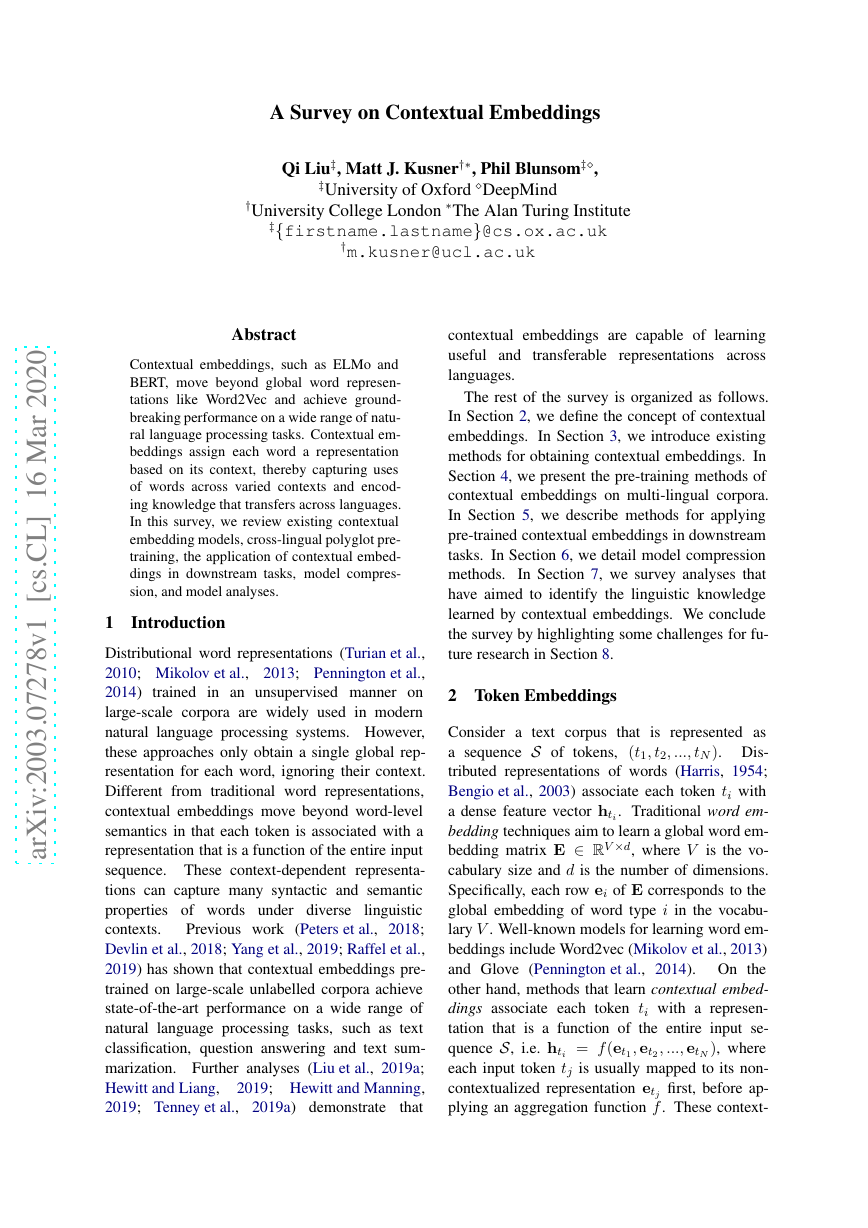

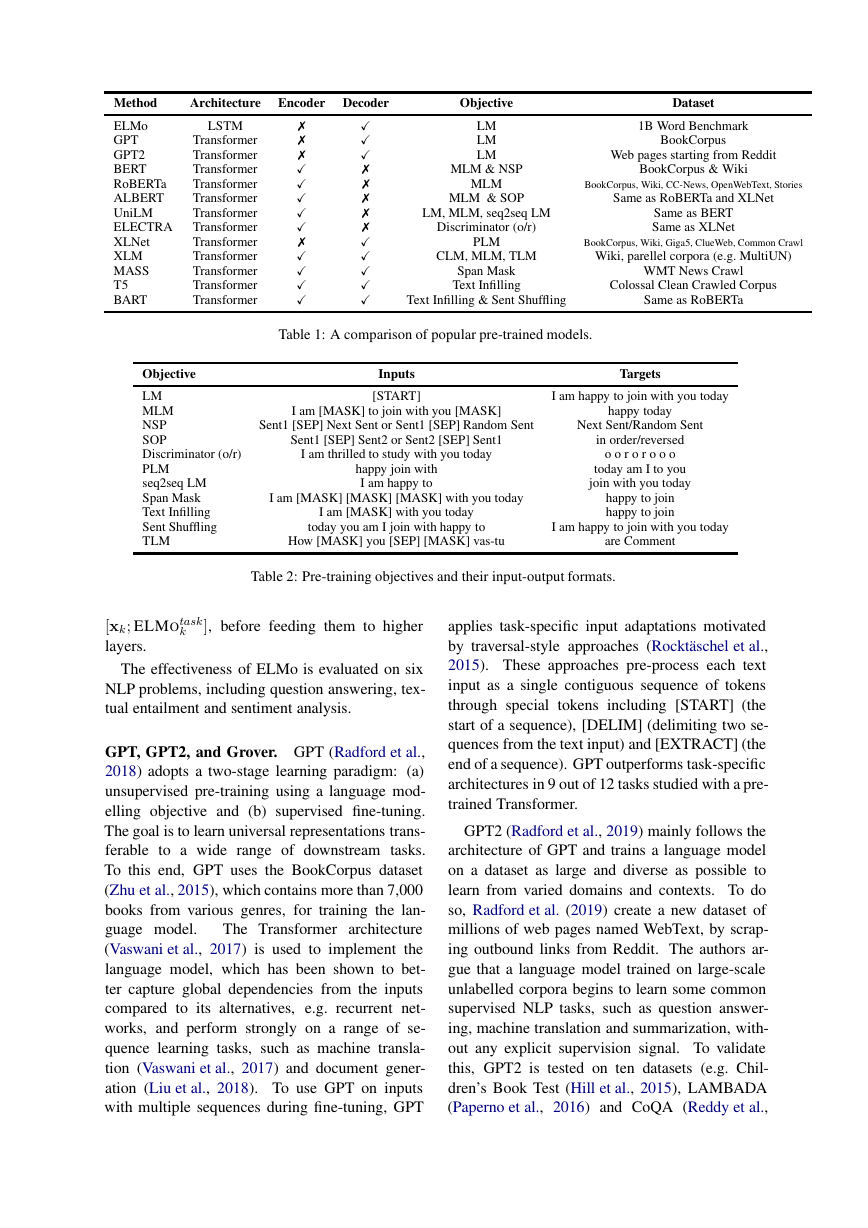

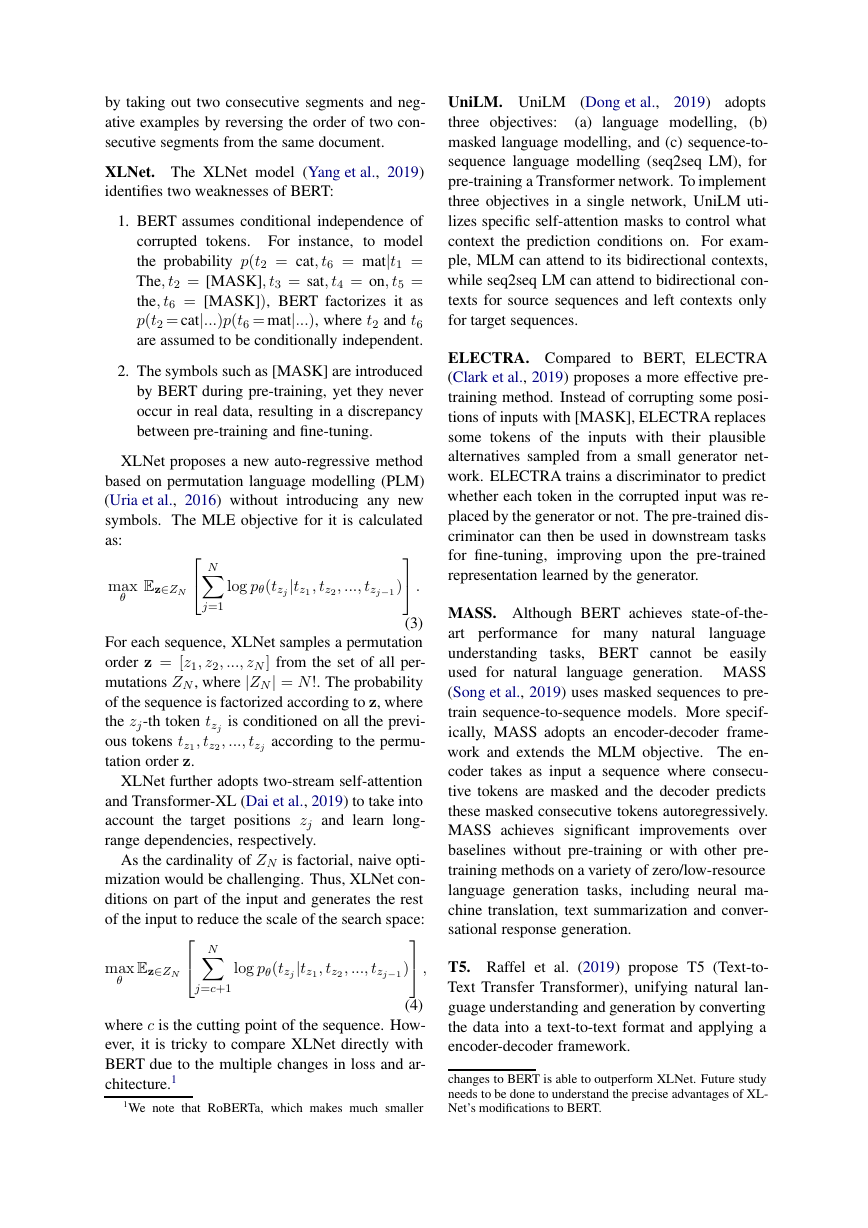
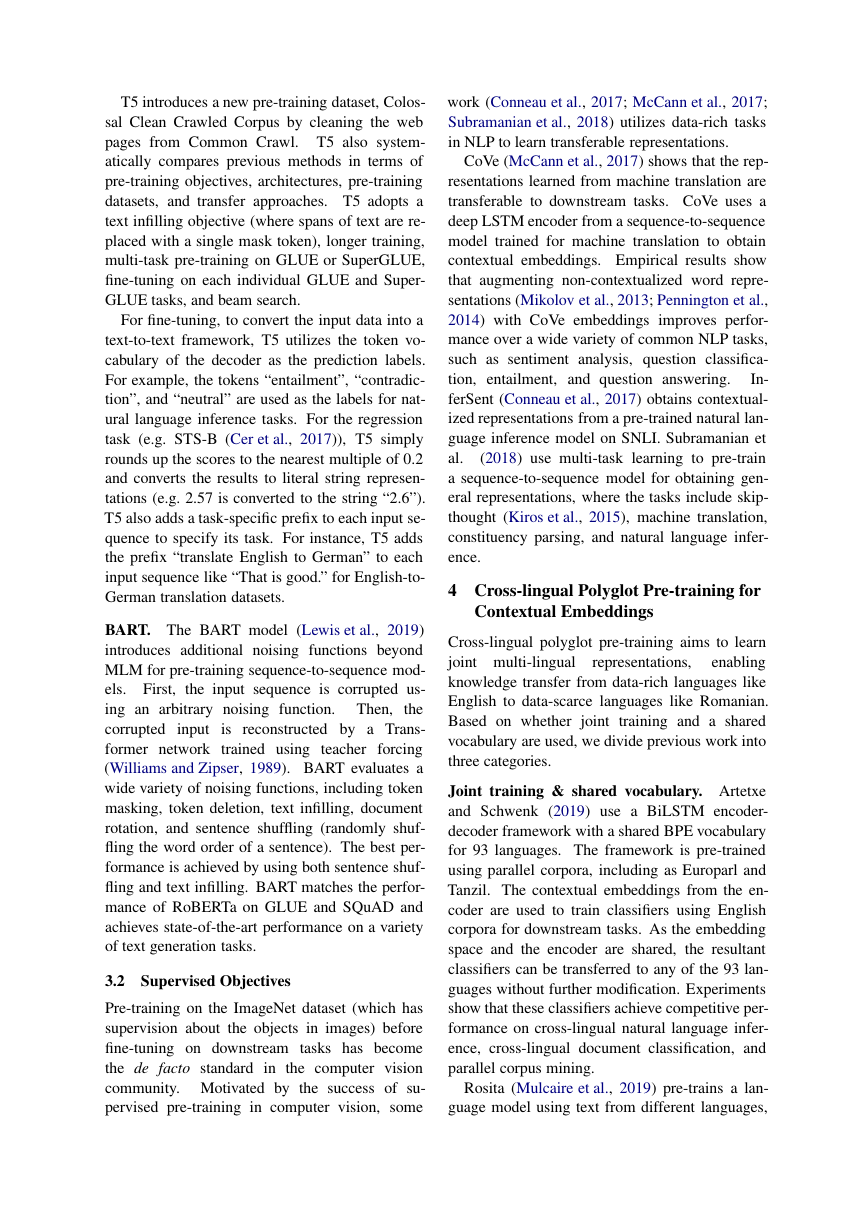
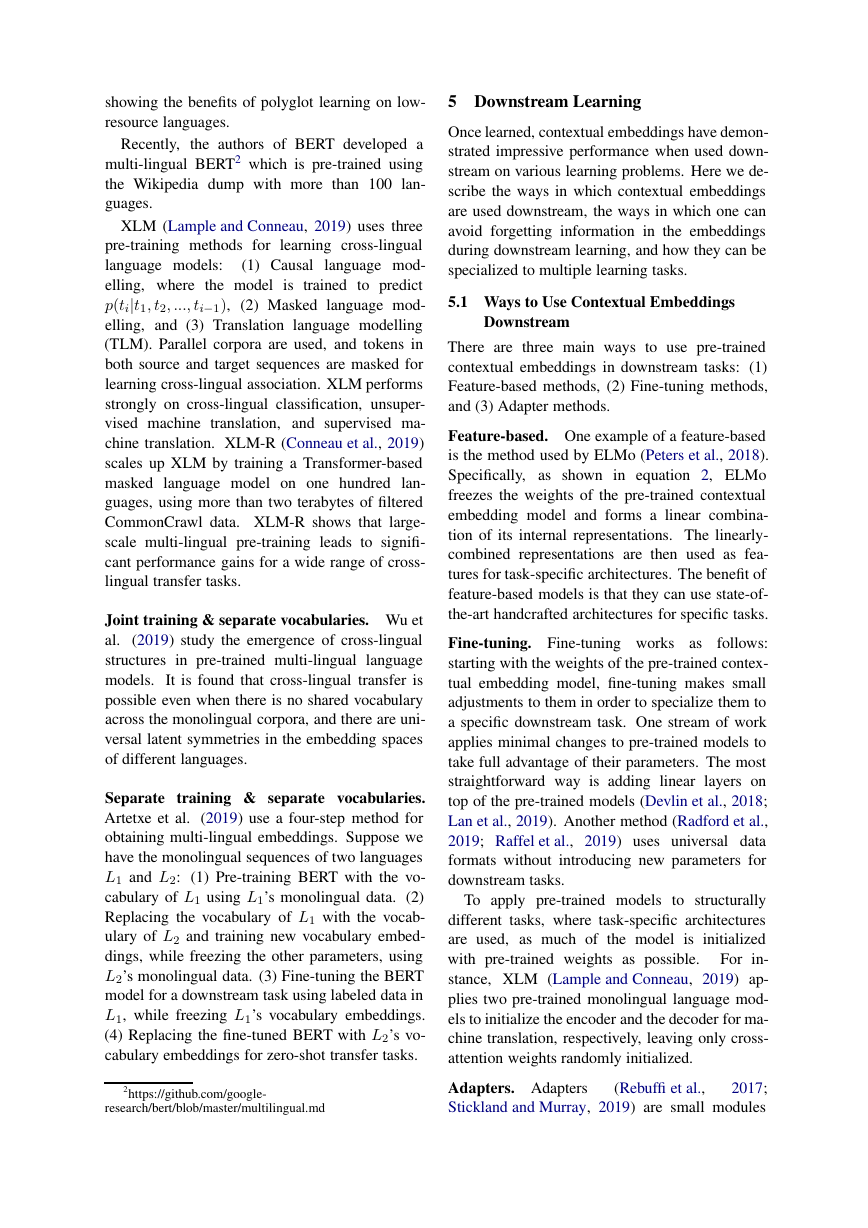
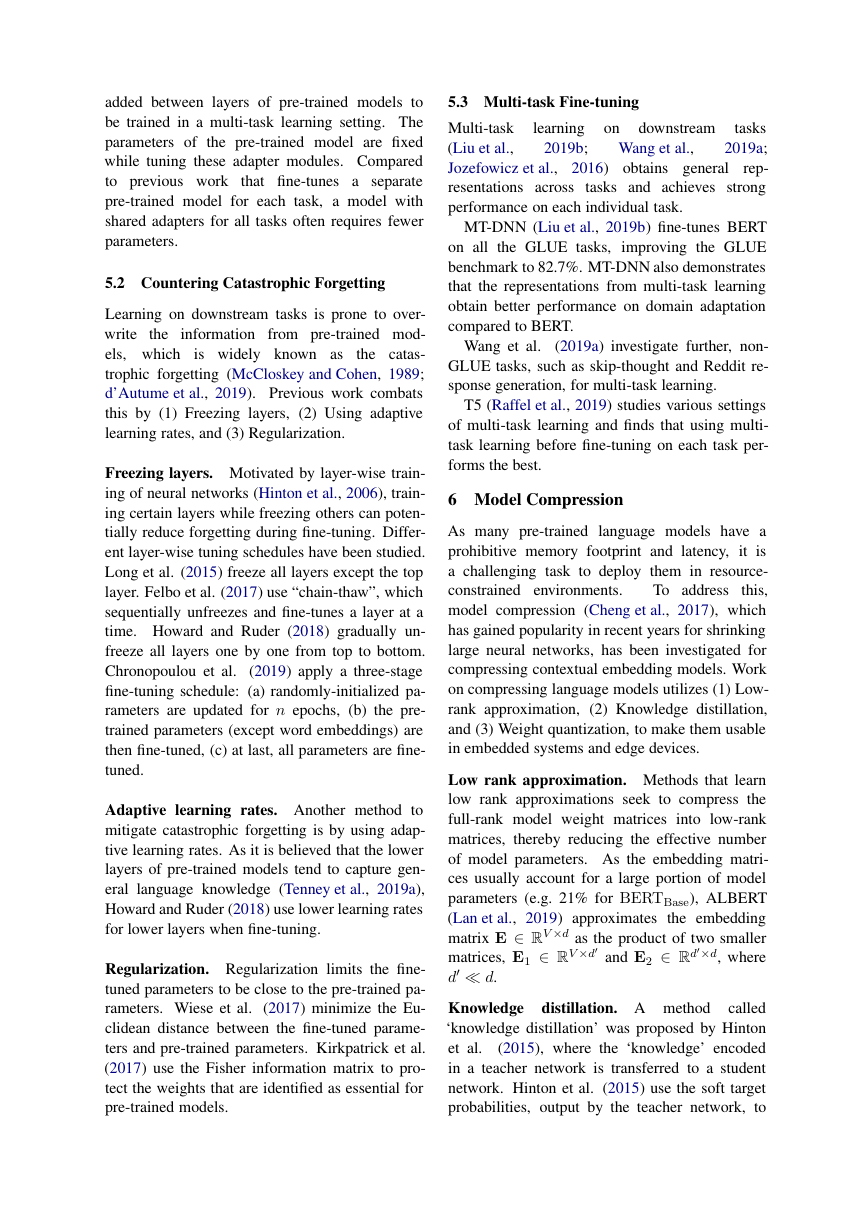








 2023年江西萍乡中考道德与法治真题及答案.doc
2023年江西萍乡中考道德与法治真题及答案.doc 2012年重庆南川中考生物真题及答案.doc
2012年重庆南川中考生物真题及答案.doc 2013年江西师范大学地理学综合及文艺理论基础考研真题.doc
2013年江西师范大学地理学综合及文艺理论基础考研真题.doc 2020年四川甘孜小升初语文真题及答案I卷.doc
2020年四川甘孜小升初语文真题及答案I卷.doc 2020年注册岩土工程师专业基础考试真题及答案.doc
2020年注册岩土工程师专业基础考试真题及答案.doc 2023-2024学年福建省厦门市九年级上学期数学月考试题及答案.doc
2023-2024学年福建省厦门市九年级上学期数学月考试题及答案.doc 2021-2022学年辽宁省沈阳市大东区九年级上学期语文期末试题及答案.doc
2021-2022学年辽宁省沈阳市大东区九年级上学期语文期末试题及答案.doc 2022-2023学年北京东城区初三第一学期物理期末试卷及答案.doc
2022-2023学年北京东城区初三第一学期物理期末试卷及答案.doc 2018上半年江西教师资格初中地理学科知识与教学能力真题及答案.doc
2018上半年江西教师资格初中地理学科知识与教学能力真题及答案.doc 2012年河北国家公务员申论考试真题及答案-省级.doc
2012年河北国家公务员申论考试真题及答案-省级.doc 2020-2021学年江苏省扬州市江都区邵樊片九年级上学期数学第一次质量检测试题及答案.doc
2020-2021学年江苏省扬州市江都区邵樊片九年级上学期数学第一次质量检测试题及答案.doc 2022下半年黑龙江教师资格证中学综合素质真题及答案.doc
2022下半年黑龙江教师资格证中学综合素质真题及答案.doc